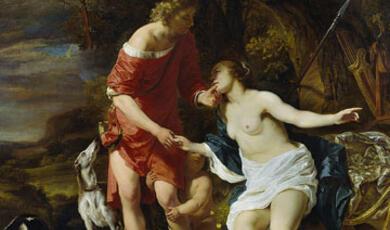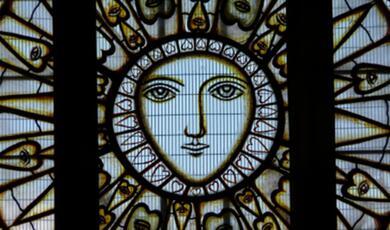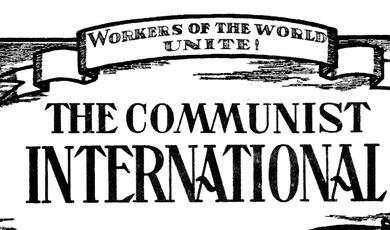St Paul's at 300
Share
- Details
- Text
- Audio
- Downloads
- Extra Reading
2011 is the 300th anniversary of the completion of Christopher Wren's Cathedral. This coincides with the completion of an historic £40 million programme of cleaning and repair, in which the building has been comprehensively restored inside and out. Now that the final scaffolding has been removed, the two million visitors and worshippers who come to St Paul's each year can witness Gresham Professor Christopher Wren's original vision, see his cathedral as fresh as the day it was completed and understand something of the changes it has undergone in its first 300 years. In a serious of two lectures (23 and 30 November) Architect Martin Stancliffe will describe this exciting project.
This lecture is the first part to the lecture on 30 November 2011.
Download Text
23 November 2011
St Paul’s at 300
(Part One)
Martin Stancliffe
The purpose of my two talks is to give some account of what has been done over the last 21 years. I believe that history may look back on us and consider this to have been a significant period. Time will tell, and it is not for me to say, but I feel that I should make an account of what I have seen and done as Surveyor to the Fabric, before I hand over to my successor.
In the role of Surveyor, Wren has been followed by a continuous line of successors. Wren’s last meeting of the commission was on 20th September 1710. Thereafter, he was around, but clearly did not play an active part. Of course, he did have to petition Parliament to pay his final salary, which was agreed to be paid on Christmas Day 1711. The Dean and Chapter has agreed with me that my final day will be Christmas Day 2011. I have yet to discover whether they intend to hand me a bag of gold on that day, but I am not hedging my bets!
Clearly, in the first years after Wren, things continued very much as before. John James was his assistant at St Paul’s and carried on when the great man stood back, and perhaps it was natural for somebody like Henry Flitcroft, a carpenter like John James, to take over from him. But as time went on, it became clear that the idea of having a Surveyor to the Fabric could not necessarily be counted on.
In the mid-18th Century, Flitcroft found himself summoned by Dean Secker to be told that, following a review of the fund set up to look after St Paul’s, the cathedral could not afford a Surveyor anymore. That produced what has been known as “Flitcroft’s Humble Memorial”, the result of which was an agreement that there should be a post of Surveyor to the Fabric. One skilful architect, both able and experienced, should have the care for the Cathedral from that point onwards, it was decided. So, we only start counting ourselves from Flitcroft.
Each Surveyor’s contribution becomes clearer over time and demonstrates how experienced and able one has actually proved to be. These lectures are to act as some kind of marker, so that history can say “The Stancliffe era was an unmitigated disaster!”
I propose to organise these two lectures in the following way. In this lecture, I shall start at 1990, when I became Surveyor to the Fabric, and look back at what I inherited. Next week, I propose to look forward to what we did over the last 20 years. I am sorry if that will mean some cliffhanging today, but I hope that it will encourage you to look forward all the more passionately to next week’s thrilling instalment.
Here is a photograph of the interior of the Cathedral as it was in 1990. It was the centrefold of the guidebook at that time, and presumably showed what the Dean and Chapter thought was the Cathedral at its best. To me, it looks a thoroughly sterile interior. You can hardly see the altar. All the liturgical elements are tucked neatly away. It is all lit by clever artificial lighting to try and make it look good, but to my way of thinking, it just looks extremely bland.
One of the things one discovers is that the Cathedral has been through all sorts of cycles where issues have come up and stayed on the agenda. Today, I want to address a number of these particular issues, but first of all, I need you to see quite clearly that the Cathedral is an extraordinarily well-built building. It is remarkably sound. It has been conscientiously looked after ever since it was built. It has been written about, drawn, and studied, probably better than almost any other building in this country.
I took a few pictures of one of my bookshelves. It has not got anything like half of the books that the Surveyor to the Fabric needs to have at his disposal in his ordinary everyday work.
Bottom left, you see the two really valuable books. One is Poley’s great collection of beautiful, accurate drawings, produced and published in the 1920s. If you are rich enough, they are available in second-hand bookshops. But also open on it is perhaps the most useful book of all, the volumes that were published by the Wren Society throughout the ‘20s and ‘30s, which show, in slightly abbreviated form, the complete building accounts of the Cathedral and the minute books.
On the left-hand side, you see something of the archive, which Bishop Michael has kindly said I had something to do with setting up, and which does indeed contain the most extraordinary collection of drawings, documents, correspondence, models and reports. All of this is now gathered together in what we call the Fabric Archive.
St Paul’s is a well-understood and well-constructed building, but it faces certain recurring issues, which I intend to address today:
The structural stability of the masonry and the dome.
The general condition of the external stonework.
The so-called ‘completion’ of the Cathedral.
The extraordinary changing patterns of liturgical use.
The use of the ancillary spaces in the crypt and triforium.
The setting of the Cathedral – the City of London.
Structural Stability
It is important to remember that, even in Wren’s lifetime, the building was showing signs of structural distress, as the ground beneath it compacted and cracks occurred under the great weight of the dome.
I like Poley’s great cross-sectional study through the dome. It somehow indicates that the dome, which weighs about 44,420 tons, seems to be suspended on nothing. You can see that it is not really supported on anything.
There are two separate issues here. One is: can the ground support it? It is worth remembering that Wren did not know what the dome was going to be like when he actually laid the foundations for it some twenty years earlier. And then, if it could support it: are there any inherit points of structural weakness in the design of the masonry or the dome?
This wonderful isometric drawing, produced in the 1920s, represents a high point in the study of the structure. Today, we cannot go in for a full analysis of all the structural movements noted, but not only did Wren find himself replacing cracked stones under the base of the dome, but Robert Milne, the great engineer surveyor of the latter half of the 18th Century, had the building closed for two years to do structural works of a substantial nature. Charles Cockerell, in the first half of the 19th Century, again noted and did a certain amount of structural work. F.C. Penrose, who was Surveyor from 1852 to the end of the century, again had his eye clearly on various signs of what he considered to be structural movement.
Some of that was caused by Wren himself. I cannot resist showing you this particular drawing, which, unless Gordon Higgott is this moment proving me wrong, I believe to be by Wren’s own hand. It is particularly interesting because it comes from two different periods. The black part is from the period of the initial design of the building, around about 1675, when the foundations were being put in. He then put it away in a plan chest, as architects do. Some twenty years later, he took it out again, and, in the blue and yellow parts, he tries to see how to put this extraordinary circular geometry over the rectilinear geometry that he has already built beneath it. You can see him wrestling with how to get the major loads that come down from the dome itself, how to get them down to ground level. It was a big challenge for him.
That did, as I say, have effects on the building. In 1897, Somers Clarke succeeded F.C. Penrose as Surveyor, after 45 years. At that point, there was a particular amount of concern on settlement of the Cathedral, arising out of proposals to construct tunnels following the Central London Railways Bill of 1890.
Somers Clarke did an amazing job. He plumbed the dome. He undertook a thorough photographic survey and installed a system of measuring points. He brought in experts to discuss where funding might come from, but he was not somebody in good health – he actually spent half his life in Egypt, with a parallel career as an archaeologist, because he suffered from asthma. I have often thought that Surveyors of the Fabric should follow his good example and spend half the year in Egypt! But such was the gravity of the responsibilities he was inheriting that he resigned in 1907, in favour of Mervyn Mccartney.
This is an excerpt from the great isometric drawing I showed you a moment ago. If you look at where the walls are indicated – for instance, down in the bottom left hand corner – you can see that although there are stones on the outside, the middle is filled with a ‘porridge’ of small stones. We now know, from work done within the last twenty years, that this porridge is actually an archaeological treasure trove. It is lots of bits of Old St Paul’s, crunched up by Wren and put in to act as the rubble-work for his structure. What happens, of course, is that that rubble-work can settle differentially from the ashlar outer skins and, with the load above it, a greater amount of load goes down the ashlar work than goes down the rubble-stone. That certainly was what caused cracking in Wren’s time, but in this period, there was a scare that St Paul’s was actually a sham building, in the sense that the rubble might be something like Aero chocolate. This scare was undoubtedly exacerbated by Sir Francis Fox, by then an old and distinguished engineer, who had a bee in his bonnet about rubble-work.
As a result, there was a great deal of pressure to grout those piers under the dome. However, as the grout failed to enter, the pressure was put up and up. A great deal of damage was caused by grout bursting out in all sorts of places, running down the face of the stonework, which then had to be replaced.
Here is a model constructed at that time of one of the piers that support the dome. There are eight of these. They did not quite know, in about 1910, how the loads from the dome were taken to ground level.
There was also a great deal of work done on how the structure actually worked. Members of this august College will know a great deal about Robert Hooke’s involvement and his contribution. These are studies done at the time, with chains, to show the lines of settlement, where they run to. It was discovered that they do not actually run down neatly to the ground, as I think Wren and Hooke hoped that they might. What actually happens is that the loads do not get resolved at the point where the base of the dome structure is carried on the top of those eight supporting arches.
Here is a drawing from the time of what was proposed to address the issues. The committees that were looking at and checking the work being developed and then instigated within the building could not agree with one another. These disagreements extended over a considerable period of time, and it was what I believe to be the purely chance extraneous event of a piece of stone - probably a piece of carving - falling from the abose on the nave roof in December 1924, that galvanised a nervy City Council into issuing a Dangerous Structures Notice. Knowing ecclesiastical timing, they of course chose Christmas Eve to serve this notice to the Dean and Chapter. That provided the impetus for completing the work that this drawing describes: a chain put in down at the bottom and a series of tie-rods, of a very complicated and extremely massively designed kind, introduced to make the whole structure work together. That work closed the Cathedral. They walled off the nave, which was the only accessible part of the Cathedral throughout the remainder of the 1920s. Between 1925 and 1930 was the period of what we call the ‘great restoration’.
The work undoubtedly provided a major strengthening of the supports to the dome and the dome itself. Whether it was, strictly speaking, as necessary as they thought it was is something which we might doubt now, but I will not go into that. That would be a very interesting separate lecture.
Mccartney retired in 1930, and he was known to have been worn out by the struggle of that particular period of work. Very sadly, he died the next year.
He was succeeded, interestingly, by Godfrey Allen, who was to be the Surveyor through the War years, but who had already been his assistant for the previous fifteen or twenty years. He therefore came into the Surveyorship already well-briefed with what the issues were, and set about making a substantial fabric of knowledge based on the discoveries of the previous fifteen years.
He saw through what we now know as the St Paul’s Depths. This is a legal instrument which puts in place a control system whereby the Dean and Chapter can at least question, if not stop, any development around the Cathedral that they believe would threaten its ground systems. That is still in place today.
He also introduced a Cathedral-wide monitoring regime of extreme subtlety and precision. Tom Thomas set it up and continued to monitor on a yearly basis, until his son, Richard Thomas, took over from him. One of my first tasks when I became Surveyor was to design and erect a memorial for Tom Thomas, who was a personal friend of the Surveyor to the Fabric two before me, Bernard Feilden.
Here is Tom, using one of those wonderful bits of equipment (which we have still in the triforium of the Cathedral) to plumb the dome. Notice the cable coming down over his left-hand shoulder, into this instrument with two weights which are in baths of oil that stop it swinging, so he can get the plumb centre of the dome. You will see that it is actually underneath the letter “E” of “Si monumentum requiris”, which tells you how out of centre it is.
There was a huge amount of work done during that time, of great stability, and one could say that it was over-engineered. Of course, you never know what is going to happen next at St Paul’s, as we have learnt from the recent Occupy protests.
Here is the effect of the bomb which pierced the North Transept roof on the night of 16th April 1941. It exploded in mid-air, destroyed the vault, plunged through into the crypt, bringing the whole crypt vault down below, and destroying, very sadly, the section of Wren’s pulpitum which had been re-erected to form a vestibule for the north entrance door. Had all that strengthening work not been done to the dome, one can only shudder at what the effect might have been on the dome itself.
But the idea of continual movement - monitored by Tom Thomas and his son – and basic instability still persisted.
When Bernard Feilden was appointed Surveyor to the Fabric in 1969, he came fresh from his structural work at York Minster, where he had been looking at supporting that great medieval tower. He had a preoccupation with structural movement.
When he met me, he said, “You know, Martin, you never want to trust structural engineers. You, as an architect, and I, as an architect, we know how the structures work and we don’t need to be lectured to by them, and we tell them what they need to calculate if they have to calculate anything.” As a result of my twenty years, I have to say that I profoundly disagree with him. I have relied on most excellent engineering advice from Alan Baxter and particularly Robert Bowles, his assistant, who has been a great tower of strength to me.
This is a remarkable Perspex model, which we still have at the Cathedral, and which was constructed at Bernard Feilden’s request. He made another one at York Minster. His intention was to show how complicated the patterns of movement were that run through the building and how important it was that they were understood and monitored and, if necessary, corrected.
He was succeeded, after not very long, by Robert Potter, in 1978. The distinguished Potter also had a bee in his bonnet about monitoring. He introduced transducers into the building, all connected to early forms of the computer.
When I took over in 1990, those computers had of course long since broken down, and I sought advice on whether they could be connected up again. I was told that it would cost at least £30,000, which led me to ask certain questions about what this minute monitoring was actually doing.
Robert Potter was mapping, in this series of contour lines, the depression of the ground underneath the Cathedral. There were a series of these done, over different times of the year, which, to me, very clearly showed that the building just went up and down, by a very small amount, depending on the time of year - but otherwise seemed extremely well in place.
Both Robert Potter and Bernard Feilden said to me, as they handed over, “You will have the pleasure and the interest of doing what neither of us could get around to doing, and that is to resolve the major outstanding problem of the outward movement of the South Transept, where the wall is clearly being pushed out southwards.” Potter told me that it was going to fall to me in my time as Surveyor to actually get to grips with this. For the story of how I got to grips with it, I am afraid you will have to wait until next week.
I have tried to demonstrate to you that there was a concern about the structure of the building, which actually went on from Wren’s time right though till 1990. This was something I had to pick up and run with.
External Stonework
External stonework has also been a matter of great interest to me and my predecessors. St Paul’s is of course an extraordinarily homogeneous construction. It is all made of Portland stone, except for niche recesses in the portico, which are Ketton. And Portland has a very interesting natural weathering pattern.
The upper storey, on the whole, stays white - the west towers, very much exposed to wind and rain, stay white. The more sheltered parts gradually go black. The sulphur dioxide in the polluted atmosphere mixes with rainwater, and where rainwater runs, the acidic action dissolves the surface of the stone. Elsewhere, the sulphation builds with carbon from the air and just builds up a black carbon crust.
The building had of course got very dirty over the first 250 years of its life, and in the 1950s, there was a great public discussion about the cleaning of all London buildings, and Portland buildings in particular. In 1958, the west front was cleaned, despite great opposition. That operation was considered to be a great success, and between 1962 and 1968, the cleaning was extended to all parts of the Cathedral.
Only the outer parts of the stonework were cleaned. We have roof pockets, which were never cleaned in the 1960s and which I have not cleaned now. They act as something of a useful scientific control, telling us about the very interesting decay mechanisms.
In the left-hand photograph, you see me indicating with my hand the amount by which the stone has eroded back from its original surface, indicated by the lead run in in the 1720s and which now stands about an inch and a quarter above the face of the stone. That has been monitored by a group of scientists for very many years now, and you can see the micrometer that they use when they come, on an occasional basis, to work out the effects of the alternation in sulphation levels in the atmosphere. This work was originally funded by the Central Electricity Generating Board. They have recently adjusted their figures from the 3.8 million initially put forward to 4.2 million years before they feel that St Paul’s will be reduced to a small pile of damp stone dust!
I would not say that the culprit behind all of that was the South Bank Power Station (now Tate Modern), but it undoubtedly produced a substantial amount of sulphur dioxide just downwind of St Paul’s Cathedral.
This has had an erosive effect on the exterior of the Cathedral for many years. One must remember that St Paul’s was, after all, built from the proceeds of coal tax back in the 17th Century.
Here is one of Francis Bird’s great figures, St Paul himself, standing on the apex of the pediment at the West Front. You can see how, in Bird’s sculptural massing, the sculpture still acts as a wonderful figure. It does not need, in my opinion, replacing, as was proposed in the 1960s. There was a movement for Henry Moore to re-carve the figures in the modern style and put the others in a museum.
The erosion patterns, of course, affect the stonework in all sorts of ways and, undoubtedly, they alter and soften all the mouldings round the Cathedral.
While we are on the subject of stonework, it is important to remember that St Paul’s is an extraordinary document, as well as being an extraordinary structure.
On the right is shown the plan that was produced of the major bombs that went off around the Cathedral during the Blitz, and on the left is a picture of the uncleaned building after the War, showing the damage on the outside. When we repaired the building ten years ago, we left that bomb damage as it is, to preserve an element of the building’s history.
There is always the question: to clean or not to clean? That was the source of a big argument in the 1950s. Nowadays, the argument is not so much whether to clean but what method to use. But you will have to wait until next week for more details in that regard.
The ‘Completion’ of the Cathedral
The completion of the Cathedral preoccupied its authorities over the years. It was always felt that, although Wren had achieved the construction of the Cathedral itself by 1711, many of his plans for the interior were left unfinished, whether due to his old age or changing tastes or lack of resources.
Between 1709 and 1710, Wren had the entire interior painted. He probably “suppled” the stone with oil first and then painted three coats on top, partly because he believed, according to other records, that oil on the surface of the stone protected it. He may have wanted to cover up what had by then become a blackened and dirty interior. You will remember that for many years it stood exposed, before they got the vaulting on. He may also have wanted to cover up the cracked stones.
In the interior of the great model, which of course pre-dates the beginning of construction of St Paul’s by just a few years, there is painted decoration. It so happens that the same team of painting and decorating contractors, used by Wren in 1709/10, were simultaneously employed at Greenwich in the great painted hall, where they painted the stonework in a similar fashion. James Thornhill then came along at Greenwich and painted decorative work on top. Was Wren proposing to do something like that? We do not know.
However, the idea of something ‘left unfinished’ began to spread and continued in the public imagination. Gwynn, in 1755, writing in London in “Westminster Improved”, referred to the “desolate appearance of the naked panels” in St Paul’s. He published this engraving, showing the interior “decorated according to the original intention of Sir Christopher Wren”. How he knew, nobody knows! You can see the way that it is covered with painted decoration of one kind or another.
In 1773, Sir Joshua Reynolds, President of the then newly-founded Royal Academy, approached the Dean with proposals that all the great academicians should be appointed to do a series of great panels that would be hung around the interior of the Cathedral, to improve its final appearance and ‘complete’ it. Nothing actually happened, perhaps fortunately.
The story of the Cathedral’s decorative ‘tos and fros’ throughout the second half of the 19th Century can only be hinted at here. On the left, you can see F.C. Penrose’s proposed decorative scheme for the chancel of the interior; on the right, Sir William Burges’ extravagant proposal for the interior, which involved cutting back the stonework by about four inches and replacing it with Italian marble.
After the 19th Century, there was a new incentive to get something done. Sir William Richmond was appointed to decorate the choir in his Byzantine character of mosaic. He intended to go further round the dome, but work was suspended because of those structural concerns I mentioned earlier.
Liturgical Layout
I now want to talk about the liturgical use of the Cathedral. As this picture shows, in Wren’s time the layout of the interior was not the same as now. There was a great pulpitum, dividing the choir from the rest of the Cathedral, with Wren’s great organ standing on the top of it.
Viewed from the inside, it was a cosy and useable place, in a building which did not have any heating and was definitely not cosy! You can see that it had light fittings: there are two candelabra hanging from the ceiling. It had a mobile pulpit and all the comforts that the Dean and Chapter would have expected for day-to-day services.
It was alright for those who were inside, but there was a certain feeling of exclusion felt by those who outside. It was perhaps not unnatural, therefore, that the dome area, and indeed the whole western part of the Cathedral, was not used during the first 150 years of the Cathedral’s life. The only rare exceptions were special events such as the great funerals of Admiral Nelson and Wellington, which brought the dome space to life and made people realise what it was capable of.
By the second or third decade of the 19th Century, people were beginning to think about what could be done. There was the adventurous suggestion, for example, of putting a great circular choir under the dome, which also seemed to exclude most of the space outside.
But it was not until the organ was in need of repair and substantial rebuilding in the 1850s and was taken down that ideas really began to take off. Once the organ was out of the way, the Dean and Chapter were able to see an extraordinary vista, right down the length of the Church.
There was considerable objection to it at the time. This is a very interesting published plan, from Micklethwaite and his partner, Somers Clarke (who would become Surveyor to the Fabric 25 years later). This is 1874, when they were proposing a semi-dome altar. The diagrams at the bottom show the angles of vision that you get from the two different altar positions. On the left hand side, if you bring the altar right forward to the edge of the dome; on the right hand side, if you rely on an altar which is right back at the east end of the Church.
Penrose, the Surveyor at the time, prepared this beautiful drawing, which we have in the Fabric Archive. It shows the stalls, as designed by Wren. He went on to do a series of drawings that showed how the stalls could be moved and adapted in order to open the whole of the Cathedral up. It would become, if you like, an enormous Victorian parish church, and that is what was achieved.
Penrose had great ideas for what might terminate this vista. He wanted a great baldaquino, of the kind that he believed Wren had had in mind but never got around to. But he never got a chance to do that because nobody could agree on what should be done. Eventually, Bodley and Garner were brought in to erect their great reredos in 1888.
This reredos was sufficiently badly damaged in 1940 to permit the Dean and Chapter to remove it after the War. Various people have said that it was not that badly damaged, but I do not think that it ever really made its way into the affections of the people. After the War, Stephen Dykes Bower and Godfrey Allen designed the great baldaquino, which is one of the great pieces of classical design in the 20th Century. It acts to terminate the choir and to form the division between it and the American chapel. It is of course scaled so as to terminate the vista down the total length of the Cathedral.
In the early 1970s, Noel Mander was brought in to rebuild the organ. He commissioned Dennis Flanders, a great architectural draftsman of the time, to put forward an idea for the organ to go back onto a somehow re-erected screen. However, these plans never got anywhere.
By the time I became involved in 1990, this was the situation. Here were the rows of chairs, plonked across this wonderful dome space, as though it did not exist, running up to the chancel rail. The chancel, as in every good Victorian parish church, stretched beyond the screen up to the High Altar. That set me a challenge, which I will return to next week.
Crypt and Triforium
When I began, I found that the crypt and triforium were in a state of semi-abandonment. My predecessor, Robert Potter, had tried to invigorate the crypt by moving the great model down there, but it was never supported by anything else, other than half-hearted audio-visual displays and royal wedding exhibitions. You had to pay to get down to the crypt in those days. The greater part of the crypt remained a really rather unattractive, blank space, lit by ugly neon lights which ran continuously round the architectural cornice moulding at the base of the vault. These lights provided the only source of light for the entire crypt.
When you open doors into the outer parts of the crypt, you find yourself in a kind of Pyreneesian underworld of old scaffolding, chains and boards.
Upstairs, in the trophy room, there were various pieces lying around, with people not really understanding what they were looking at. In other roof spaces around the triforium were the remains of extraordinary Victorian models and various other things.
The triforium is a very atmospheric space. On the left of this photograph you can see the stones and archaeological elements that Penrose collected from his discoveries of Old St Paul’s. This gives an indication of what might, one day, be possible up there. More people might then get to see Wren’s extraordinary and atmospheric library.
Setting
You will remember Holford’s great Paternoster scheme, with the Chapter House cut off at the knees by the fact that Paternoster Square was raised up a flight of stairs. We should remind ourselves that Wren produced a clear and strong division between the Cathedral precinct and the streets outside. The section of railings at the western end was moved when the area at the foot of the steps was thrown open to the City in the 1860s, for the good of its inhabitants.
St Paul’s has, since its earliest days, stood proudly above the rooftops of London, as this drawing by Caneletto demonstrates.
The 1930s saw the construction of Faraday House - the great Portland stone building which, if you stand on Blackfriars Bridge, blocks the view of the Cathedral. Godfrey Allen realised that unless some substantial action was taken to limit the height of the new construction, these views would be lost for all time. He worked very hard to implement, almost single-handedly, a system for controlling and understanding the effect that increased heights would have on the views of the Cathedral. His code of practice, called the “St Paul’s Heights”, is still enforced by the Corporation of London, and we are very grateful for it.
Following the Blitz, the way was open for Sir William Holford to introduce his ideas about how a city should look and function. He cheerfully disregarded the St Paul’s Heights Code. I do not think time ever softened his rather harsh vision, and I think few regret its passing now.
Next week I shall be discussing the work we have carried out on the Cathedral over the course of the last 21 years.
© Martin Stancliffe 2011
This event was on Wed, 23 Nov 2011
Support Gresham
Gresham College has offered an outstanding education to the public free of charge for over 400 years. Today, Gresham College plays an important role in fostering a love of learning and a greater understanding of ourselves and the world around us. Your donation will help to widen our reach and to broaden our audience, allowing more people to benefit from a high-quality education from some of the brightest minds.


 Login
Login







